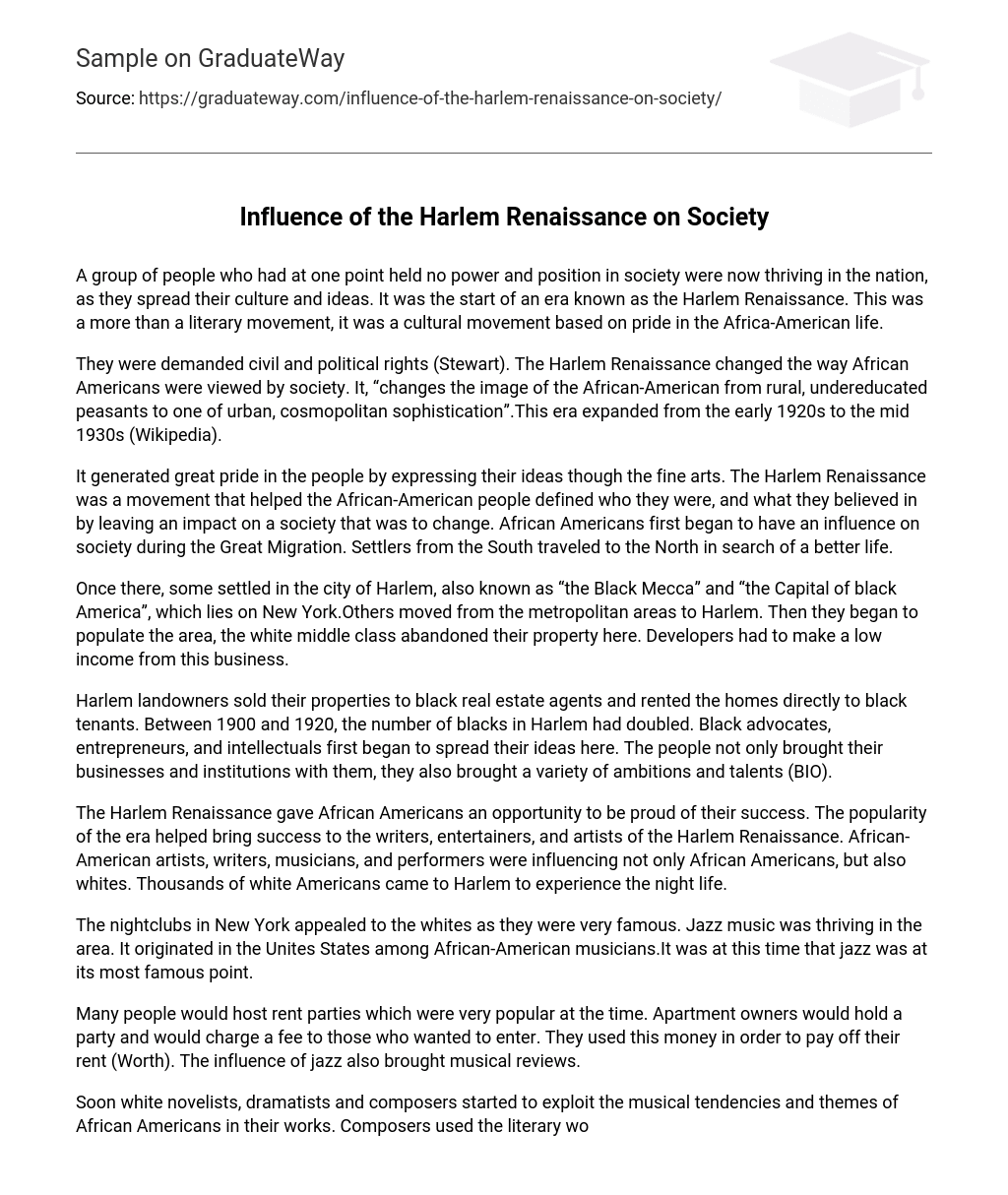The Harlem Renaissance was a time when marginalized individuals who lacked power and position in society began to thrive by sharing their culture and ideas. This period encompassed not only literature but also the promotion of pride in African-American life, making it both a literary and cultural movement.
According to Stewart, African Americans demanded civil and political rights. The Harlem Renaissance, which lasted from the early 1920s to the mid 1930s, brought about a change in how society perceived them. It transformed the image of African Americans from rural, undereducated peasants to urban, cosmopolitan sophistication (Wikipedia).
The expression of ideas through the fine arts generated immense pride among the people and played a significant role in the Harlem Renaissance movement. This movement not only allowed African Americans to define their identity and beliefs but also left a lasting impact on a society that was undergoing change. The Great Migration marked the beginning of African Americans’ influence on society as migrants from the South sought better opportunities in the North.
Upon arrival, some people decided to settle in Harlem, a city known as both “the Black Mecca” and “the Capital of black America,” located in New York. Meanwhile, others moved from nearby metropolitan areas to Harlem. This led to a gradual takeover of the region by these newcomers, causing the white middle class to give up their properties. Consequently, developers recognized the potential for profit through low-income housing in this particular area.
From 1900 to 1920, landowners in Harlem sold their properties to black real estate agents and rented homes directly to black tenants. This led to a doubling of the black population in the area, bringing with it businesses, institutions, ambitions, and talents. Harlem became a hub for black advocates, entrepreneurs, and intellectuals (BIO).
The Harlem Renaissance provided African Americans with a chance to rejoice in their accomplishments, as it brought triumph to writers, entertainers, and artists from this time period. Additionally, African-American artists, writers, musicians, and performers exerted a notable impact not just on fellow African Americans but also on white individuals. Numerous white Americans were drawn to Harlem with the intention of immersing themselves in its vibrant nightlife.
The nightclubs in New York were popular among white people due to their fame. Jazz music, which was thriving in the area, originated in the United States among African-American musicians. This was the period when jazz reached the height of its popularity.
During this period, rent parties gained immense popularity as many people organized them. These parties were hosted by apartment owners who charged a fee for entry. The money collected from these parties was used to pay the rent (Worth). Additionally, the rise of jazz also led to the emergence of musical reviews.
White novelists, dramatists, and composers quickly started integrating African American musical styles and themes into their works. Composers began incorporating the writings of African-American poets into their songs, resulting in a fusion of African-American and white influences in classical music. This phenomenon is well-documented on Wikipedia. Furthermore, the artworks of these artists gained visibility through publication in magazines nationwide.
The rapid spread of their culture and the Harlem Renaissance also gave rise to Harlemania, a phenomenon that impacted both white and black communities. This trend was characterized by individuals of the era expressing their unique style through fashionable clothing and intricate decorative elements. People adorned themselves in luxurious attire, and their homes reflected a lavish aesthetic.
They had expensive decorations from foreign nations, such as Worth. One person even said “You have never seen such clothes. . .”
According to Worth, fur coats are not limited to using only one type of fur. They improve gray fur coats by incorporating ermine collars and add black fur collars to ermine coats. Moreover, they embellish these coats with ropes of jewels and trailing silks in vibrant colors.
The Harlem Renaissance offered African-Americans an opportunity to voice their political beliefs, resulting in the establishment of the National Association for the Advancement of Colored People (NAACP). The NAACP aimed to combat discrimination by promoting equality across various domains including politics, education, society, and the economy.
B. DuBois, a renowned African-American poet, assumed leadership of the NAACP, while Marcus Garvey, another distinguished figure in society, played a political role by establishing the Universal Negro Improvement Association. Nevertheless, their beliefs differed from those upheld by the NAACP.
Garvey promoted self-reliance for African-Americans and urged them to avoid depending on white assistance. His goal was to unite and inspire all black individuals, encouraging them to return to Africa and promote their cause. This movement, referred to as the “Back to Africa Movement,” gained significance during a period when interracial matters were being addressed.
The Civil Rights movement greatly benefited from the Harlem Renaissance as it played a significant role in advancing political rights. Individuals, regardless of their race, challenged societal norms and united to pursue shared interests. The cultural movement of the Harlem Renaissance directly confronted various concerns related to individual and civil rights (Stewart).
It promotes self-reflection among white individuals about their country’s interests, such as their ability to engage with people from diverse racial backgrounds or if they tend to only socialize within their own circles. They are committed to achieving equal treatment and rights, which drives them to find avenues for expressing their convictions.
The Harlem Renaissance, a significant era in US history lasting approximately 15 years, saw the rise of artists, writers, and performers in Harlem. Consequently, Harlem became a prominent hub for American culture as these leaders produced exceptional works that greatly contributed to enriching the nation’s cultural landscape.
According to Worth, they had a significant impact on subsequent African-American writers and artists, urging them to leave a lasting imprint on the cultural customs of the United States.





